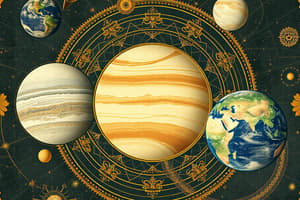Podcast
Questions and Answers
If Earth were the size of a dime, Mars would be about as big as an ______ tablet.
If Earth were the size of a dime, Mars would be about as big as an ______ tablet.
aspirin
Mars orbits our Sun, a ______.
Mars orbits our Sun, a ______.
star
Mars is the ______ planet from the Sun at an average distance of about 228 million km.
Mars is the ______ planet from the Sun at an average distance of about 228 million km.
fourth
One day on Mars takes a little over ______ hours.
One day on Mars takes a little over ______ hours.
Mars has two moons named Phobos and ______.
Mars has two moons named Phobos and ______.
Mars is known as the Red Planet because iron minerals in the Martian soil oxidize, or ______, causing the soil and atmosphere to look red.
Mars is known as the Red Planet because iron minerals in the Martian soil oxidize, or ______, causing the soil and atmosphere to look red.
NASA missions have found lots of evidence that Mars was much ______ and warmer, with a thicker atmosphere, billions of years ago.
NASA missions have found lots of evidence that Mars was much ______ and warmer, with a thicker atmosphere, billions of years ago.
Mars was named by the ancient Romans for their god of ______ because its reddish color was reminiscent of blood.
Mars was named by the ancient Romans for their god of ______ because its reddish color was reminiscent of blood.
The Egyptians called Mars '______ Desher,' meaning 'the red one.'
The Egyptians called Mars '______ Desher,' meaning 'the red one.'
Scientists don't expect to find living things currently ______ on Mars.
Scientists don't expect to find living things currently ______ on Mars.
From an average distance of 142 million miles, Mars is 1.5 ______ units away from the Sun.
From an average distance of 142 million miles, Mars is 1.5 ______ units away from the Sun.
Mars' axis of rotation is ______ 25 degrees with respect to the plane of its orbit around the Sun.
Mars' axis of rotation is ______ 25 degrees with respect to the plane of its orbit around the Sun.
Flashcards are hidden until you start studying
Study Notes
Mars: The Fourth Planet from the Sun
- Mars is a dusty, cold, desert world with a thin atmosphere and experiences seasons, polar ice caps, extinct volcanoes, canyons, and weather.
Mars' Size and Distance from the Sun
- Mars is about half the size of Earth, with a radius of 2,106 miles (3,390 kilometers).
- If Earth were the size of a dime, Mars would be about as big as an aspirin tablet.
- Mars orbits the Sun at an average distance of about 228 million km (142 million miles) or 1.52 astronomical units (AU).
Mars' Rotation and Orbit
- One day on Mars takes a little over 24 hours, with a rotation period of 24.6 hours.
- A year on Mars lasts 687 Earth days, with Martian days called "sols".
- Mars' axis of rotation is tilted 25 degrees with respect to the plane of its orbit around the Sun.
Composition and Atmosphere
- Mars is a rocky planet with a solid surface altered by volcanoes, impacts, winds, crustal movement, and chemical reactions.
- Mars' atmosphere is thin and composed mostly of carbon dioxide (CO2), argon (Ar), nitrogen (N2), and small amounts of oxygen and water vapor.
Moons and Exploration
- Mars has two moons, Phobos and Deimos, and no rings.
- Several missions have visited Mars, including flybys, orbiters, and rovers on the surface.
- The first successful Mars mission was the Mariner 4 flyby in 1965.
Potential for Life
- Mars is not currently capable of supporting life as we know it.
- NASA missions have found evidence that Mars was once wetter and warmer, with a thicker atmosphere, billions of years ago.
Mars' Red Color
- Mars is known as the Red Planet due to iron minerals in the Martian soil oxidizing, or rusting, causing the surface and atmosphere to appear red.
- Mars was named by the Romans for their god of war due to its reddish color, reminiscent of blood.
Studying That Suits You
Use AI to generate personalized quizzes and flashcards to suit your learning preferences.



